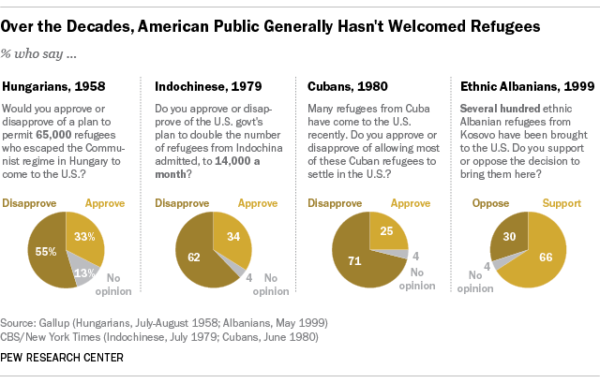The Middle East Monitor reports on a new study by the Pew Research Center that found that nearly half of all refugees admitted to the U.S. in 2016 are Muslims.
Released on Wednesday the study indicated that a a total of 38,901 Muslim refugees entered the U.S. in fiscal year 2016, making up almost half (46%) of the nearly 85,000 refugees who entered the country in that period.
It went on to say: A slightly lower share of 2016’s refugees were Christian (44%) than Muslim, the first time that has happened since fiscal 2006, when a large number of Somali refugees entered the US. Approximately 12,486 refugees to the US came from Syria and 9,012 from Somalia while 7,853 refugees came from Iraq, 3,145 from Myanmar and 2,664 from Afghanistan.
Yet while the number of refugees in the US has become a major issue in current domestic policy, the total number of refugees in the country pales in comparison with those accepted by some of the world’s poorest countries. For instance, a recent Amnesty international report shows that more than 50% of the world’s refugees have been absorbed by only 10 countries including Jordan and Turkey which host more than 2.5 million refugees each and Pakistan and Lebanon which host more than 1.5 million each.
According to an Amnesty international spokesperson: A small number of countries have been left to do far too much just because they are neighbours to a crisis… That situation is inherently unsustainable, exposing the millions fleeing war and persecution in countries like Syria, South Sudan, Afghanistan and Iraq to intolerable misery and suffering.
 Other Key Findings
Other Key Findings
Some other key findings from the Pew study confirm what has already been suggested through personal accounts and news reports. 1 in 100 people worldwide are displaced from their homes, the highest recorded count since the United Nations High Commissioner for Refugees began keeping track in 1951. About six-in-ten Syrians, or 12.5 million people, are now displaced from their homes, a number unprecedented in recent history for a single country.
The report has a number of useful graphs and infographics to support the story, including an interesting look at shifts in the origins of refugees to the US over time as well as American attitudes toward accepting refugees. In general, the U.S. public has seldom approved of welcoming large numbers of refugees. Opponents charge that refugees are not adequately vetted and pose security threats to the United States if allowed to resettle here, allegations that have been refuted by researchers.
Why does this information matter?
Migration and refugee trends are likely to continue for the foreseeable future; as a result, host countries will have to confront related social issues and their leaders must grapple with policies that policies that do not align with the enormity of the problem. Influxes of large foreign populations will provoke ongoing racist and Islamophobic rhetoric and actions which can be harmful to both targeted communities and bystanders, young and old alike. Stereotypes and misperceptions will persist and educators will find themselves in the position of helping children unpack difficult ideas and words that teachers themselves find difficult to understand.
What can you do as an educator?
You can start by learning the facts on the ground shared in these reports and separating fear from reality by educating yourself about the refugee situation in your own community, city, state, and beyond.
This issue can also be used to discuss civic and global responsibility during times of conflict. How can local communities and countries work together to remedy humanitarian disasters? Children can begin to understand their place and role in a very connected world. Why, for instance, do some countries have much higher numbers of refugees than the United States?
TeachMideast can help you with ideas to tackle this sensitive subject with young learners by beginning to humanize this global phenomenon. Please contact us with your questions and concerns.

